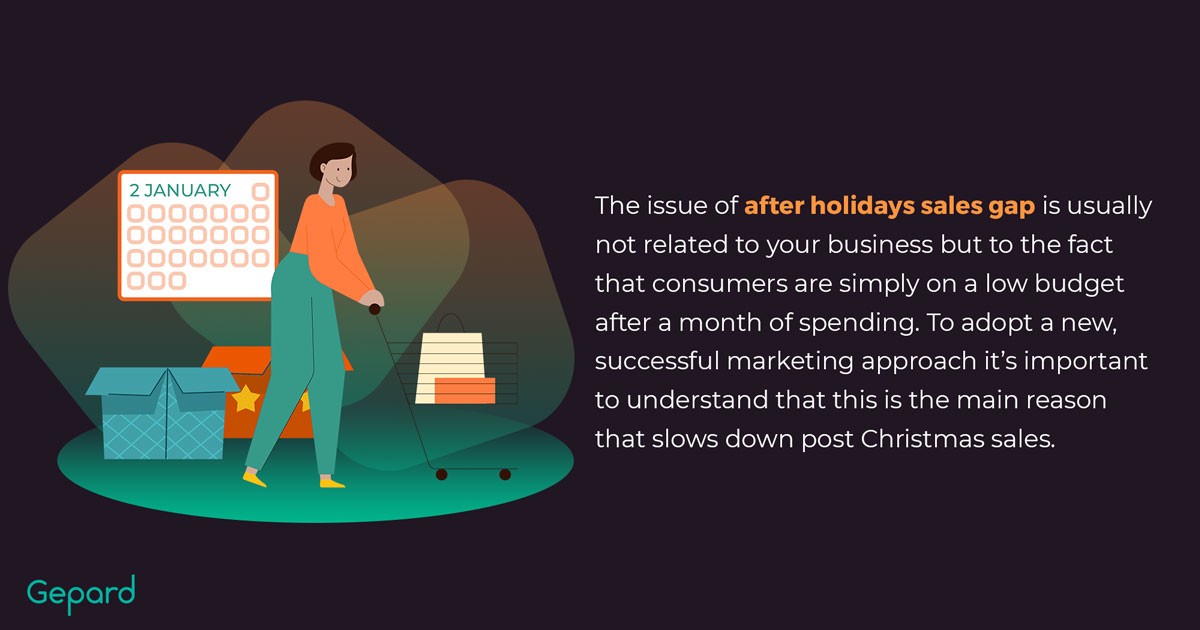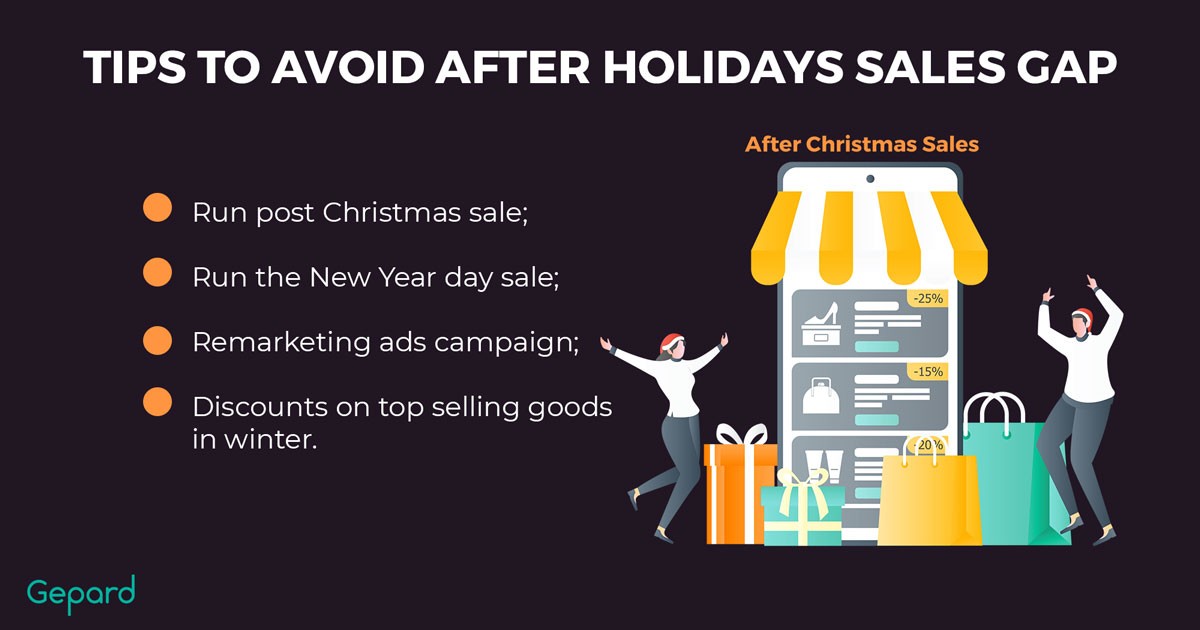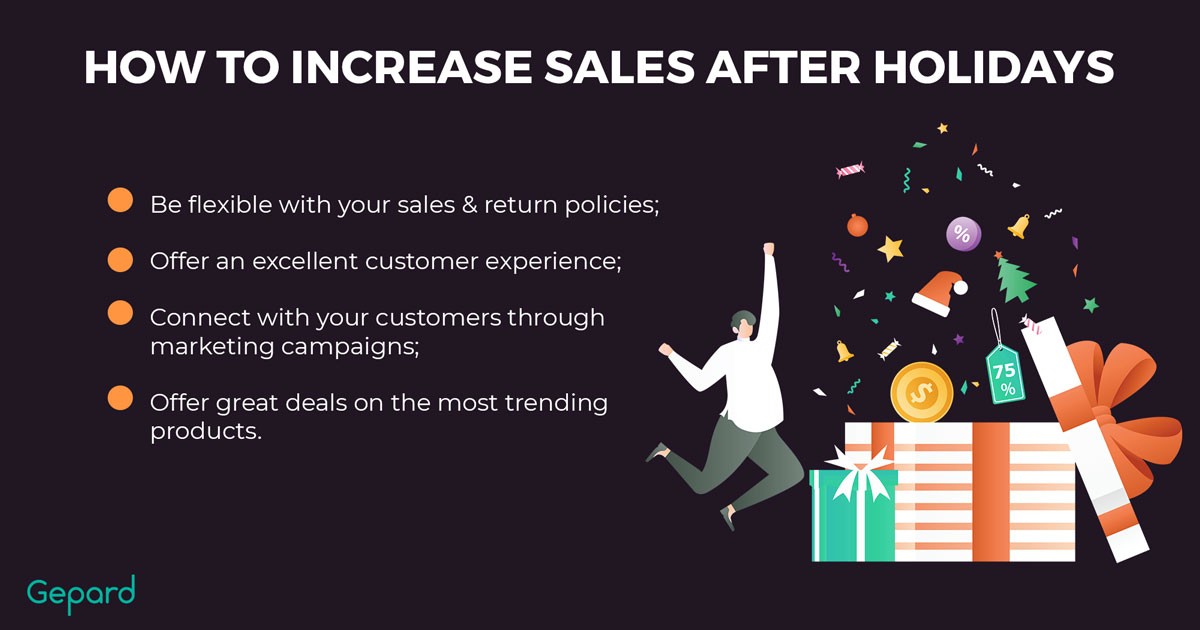How To Avoid The After Holiday Sales Gap
After holiday sales drop is not uncommon, it’s something that retailers experience at the beginning of every year. People tend to take a break from shopping after December since they have spent a good amount on presents and celebrations over the month. As a result, companies are forced to figure out how to keep different revenue streams active to avoid any gaps that come after. This is precisely where creative marketing strategies come into play.
What Are Spike Sales?
What Are The Winter Holidays For eCommerce?
Profits in the 4th quarter are crucial and often determine the success level a business will have at the beginning of the next quarter. Thanks to all of the celebrations that take place at the end of the 4th quarter, businesses are able to make the most out of this period by holding both offline and online holiday sales.

If you find it hard to keep up, and find yourself asking “when do the winter sales start”, we laid everything out in the below table:
| Holiday | Thanksgiving | Hanukkah | Christmas | New Year |
| Holiday Date (2021/2022) | 25.11 / 24.11 | 28.11 – 06.12 / 18.12 – 26.12 |
25.12 | 31.12 – 01.01 |
| Sales Start Date | A week before the holiday | A week before the holiday | A month before (on 30.11 – 01.12) | At the beginning of December |
In order to plan out your operational tasks successfully throughout this time, it’s worth understanding some important facts about holiday sales:
- As of 2019, an average consumer in Europe spent an estimated €461 during the November-December celebrations. Thanks to the broadening variety of shopping methods this number was much bigger than in previous times.
- Companies generate an impressive 19% of total annual retail sales specifically during the December shopping season. In addition, in 2021, the number is potentially going to rise due to the gradual improvement of consumers’ overall financial well-being post the COVID-19 pandemic peak.
- Online revenue is expected to reach $6.388 billion by 2024. Every year, the amount of money spent on the Internet increases as more companies are switching to selling online.
- In Europe, Christmas shopping in 2021 started as early as June. This is also an effect of events related to the pandemic. Some consumers tend to be more cautious of their financial situation and to avoid any last-minute expenses, trying to plan out their spending on gifts early.
How To Avoid The After Holidays Sales Gap
Taking action in the middle of the fourth quarter is the key to avoiding a drop in sales after New Year. Adopt strategies to increase client loyalty and trust, as well as encourage consumers to take advantage of your after holiday sales and deals.
Run Post Xmas Sale
To avoid the gap, it’s worth going over some of the sales drop off ideas that can be implemented by your business. Holding a campaign with after Christmas ads displaying significant discounts is one of the most popular methods. Keep in mind, late December to January is when most product returns take place. Making it the perfect time to optimize your return policy and upsell on exchange requests and offer product warranties at a reasonable price. Global brands like Nike, are known for featuring clearance promotions throughout January. Certain collections have discounts up to 50% off without any special coupons.
Try New Year Day Sale
With 10% of holiday purchases occurring in the final week of the year, running New Year’s sales ads up until the 31st of December and even as late as the first week of January can serve as an extra boost. Discounts should be substantial, as the majority of consumers have completed their shopping and need an extra incentive to buy more products. Another effective marketing technique is featuring New Years Day sales with a high percentage of discounts, this can also greatly benefit your stock clearance plans. Online retail giant, Amazon, is no stranger to successfully implementing New Years Day sale campaigns, featuring great deals specifically on consumer electronics.
Run remarketing ads campaign
If you are planning on featuring after Christmas clearance sales, your best audience are those that already interacted with your shop or marketing campaigns. Data shows that the average click-through rate on ads that are retargeted is 180.6% higher than those that were run initially. This is exactly why retargeting is the right strategy.
Offer discounts on top selling items during winter
Knowing your client base and their preference is key for any retailer. When it comes to boosting your after new years sales it’s especially important to research the trends and customer preferences of the market you are targeting. For example, during the colder months, 79% of shoppers in the UK want an online shop to have low-cost delivery, 55% buy clothes, and 18% shop for consumer electronics. Knowing numbers like these will help you determine the type of discounts to offer on top selling items during winter. Sportswear companies like Adidas effectively utilize this technique and annually hold big deals on their top selling winter products.

Closing Notes: Will It Happen To Me Every Year?
After all of the celebrations are done, it’s normal for a business to experience a post Christmas sales gap. All you have to do is be aware of the matter, conduct research in advance and follow industry best practices to minimize the damage to your revenue.
To avoid losing time, begin planning for next winter season right after this year’s campaign. By analyzing and drawing conclusions it’s possible to devise an effective marketing plan for the coming year. Additionally, to run more accurate New Year’s sales ads, aim at tracking consumer trends over the next 12 months.
Holiday Sales FAQ
How Do I Sell After Christmas?
Throughout the season, it’s a great idea to give out gift cards that can be applied on the next purchase. This will be an incentive for people to come shop with you even after the peak is over. Consider making the experience of those customers a bit more personal as they are your returning buyers. Offering high bargains on collections that are in high demand, accurate retargeting campaigns, buy one get one free promotion, and loyalty discounts are all great ways to sell effectively after Christmas.
What To Sell After The Holidays?
Examine your product range and research what people need throughout December to February. For instance, warm clothes, heaters, snow cleaning equipment, waterproof items, indoor workout and winter sports equipment, etc.
Are Sales Always Slow After Christmas?
The issue often is not so much related to how retailers operate, but to the fact that consumers are simply on a low budget after a month of spending. To adopt a new, successful marketing approach it’s important to understand that this is the main reason that slows down post Christmas sales.
How Can I Increase Sales After Christmas?

Usually, it’s the small things that drive customers to your shop. Consider implementing the following to give your business a boost:
- Be flexible with your policies;
- Increase attention to customer experience;
- Stay connected with your customers via marketing campaigns;
- Offer great deals on products in high demand.
How Can Gepard Help Your Business Handle The After Holiday Sales Gap?
Both during and post the holiday season eCommerce retailers find themselves handling a large amount of product information. This period is hard as complying with numerous requirements of marketplaces is an extremely time-consuming task. This is especially the case when the information needs to be updated manually.
This is where efficient product information management can really help your business. Gepard offers a customizable solution that helps manage product content automatically. This is achieved via standardized data, structured in a single format which allows you to have a smooth workflow and integration features with multiple revenue channels.
Request your personalized demo to learn how product information handling can be an effortless task during the time your business efforts are needed elsewhere.





